Even when winter brings a deep freeze, most chickens will do fine. They have upwards of 10,000 feathers. The downy ones provide insulation and the harder, tighter outer feathers provide protection from wind, rain and snow. As long as the hens have shelter that is dry and draft free, they’ll be plenty warm. You might be worry about those areas not covered by feathers. There’s a risk, but with proper management, it’s not big. Although there’s no insulation in these chicken feet, and yet Twiggy and the other hens are able to walk on the frozen ground.
According to the Cornell Lab of Ornithology, birds rarely get frostbite in their feet. This is because there is very little fluid in the cells of their legs to freeze, and because their blood circulates so fast back into warmer parts of the body that what is there doesn’t have time to freeze. They don’t need insulating feathers on their feet to stay warm. In fact, I think that my Cochin, Pearl, has the coldest feet of the lot because her feathers get muddy and then icy. She also doesn’t have those protective hard outer feathers. It’s important to have dry housing for Cochins.
That said, chickens forced to stand on ice all day will get frostbite in their toes. Your hens must spend most of their winter days on dry bedding and on roosts. Given the right options, they’ll keep themselves safe.
Combs are susceptible to frostbite. Chickens like Wyandottes, with their close to the head rose combs are called winter hardy because they have a low risk of damage. Onyx, the Barnevelder, has a small comb that poses no risk of frostbite.
Other hens in my flock, despite larger combs, also weather the weather fine. Their combs go grey and shrink a bit, but this is not frostbite. Misty’s comb is bright red and floppy in the summer, but this is what it looks like now.
Jasper’s tall comb remains red, though it’s a tad smaller than her summer hat.
In twenty years of chicken keeping, I’ve never had a case of frostbite, but that doesn’t mean that it can’t happen. When the air is damp, moisture will cling to combs, then freeze, causing the tips to die. I’ve heard from people who have chickens that have gotten frostbite. In one case, the coop was so well-insulated that the air inside became damp; this was in northern Canada, where it is really, really cold. In that case adding vents to reduce the humidity inside of the barn, and installing a radiant heater (the safest type for a coop, as it doesn’t have coils that can spark a fire) solved the problem. Another coop was further south, but the combination of no ventilation and not enough mucking out of manure caused the problem. That was solved with management, not a heater.
I recently heard from a reader with a perfectly designed coop which is dry and clean. A couple (not all) of her hens got frostbite. This is what frostbite looks like – note that the tips of the comb are black. (The comb is shiny from ointment.)
Frostbite is not a condition to ignore. It can be painful. The dead tips can fall off and become infected. The color change can cause pecking issues amongst hens. Roosters will have a drop in fertility. This hen was treated with bacitracin, and a day later looked much better. (She did get dirt on the sticky stuff, and so the comb looks dark, but that’s not more frostbite.) You can clearly see the typical white tips caused by frostbite.
The question is, why did this hen get frostbite? After much back and forth with her owner, I think that we figured it out. The day that this happened it was blowing which caused the windchill factor to dip so dangerously low that school was delayed. Her hens stayed smartly inside. But, she still had the pop-door open. This hen is low on the pecking order, which means that she was the one delegated to stand closest to the windy opening, and so got frostbite.
If your chicken does get frostbite, bring her in and clean the affected area with a warm saline solution. Blow dry her. Slather with an ointment like bacitracin, or for a natural soother, aloe vera. If she appears to be in pain, you can use an analgesic cream found at your pharmacy. Then, I’d put her right back out with the flock. If the damage is so severe that the others peck at her, then you’ll have to isolate until healed, but be aware that it will be difficult to reintegrate her with the flock later, so it’s not a kindness to keep her inside if you don’t have to. Then, reevaluate your coop. Is it dry? Is it large enough so that all of the hens can be inside and active even during bad weather? Are the hens protected from the wind? In the case illustrated here, you can be sure that on days when the weather service warns about the windchill factor, that the hens will be inside (it’s a lovely coop with big windows) and that pop-door will be closed.
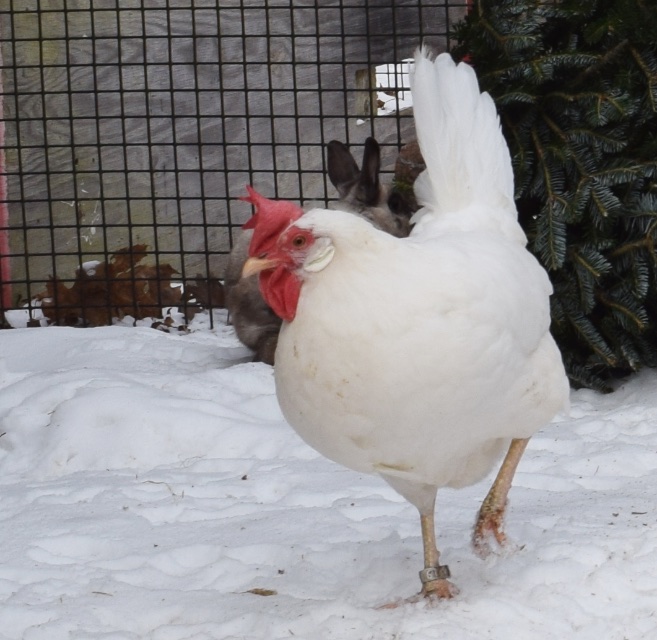

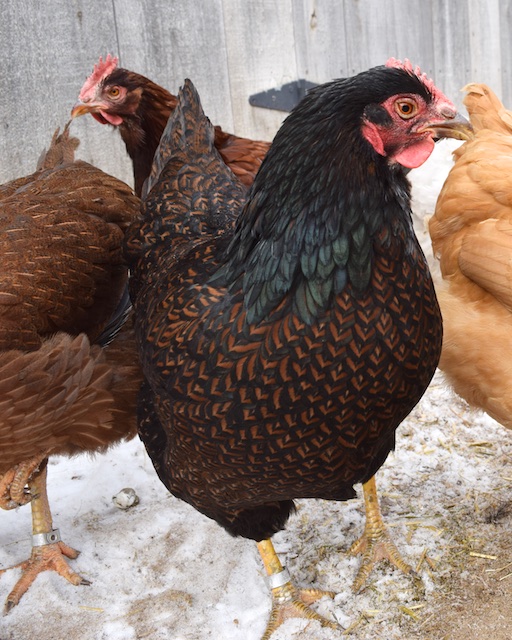
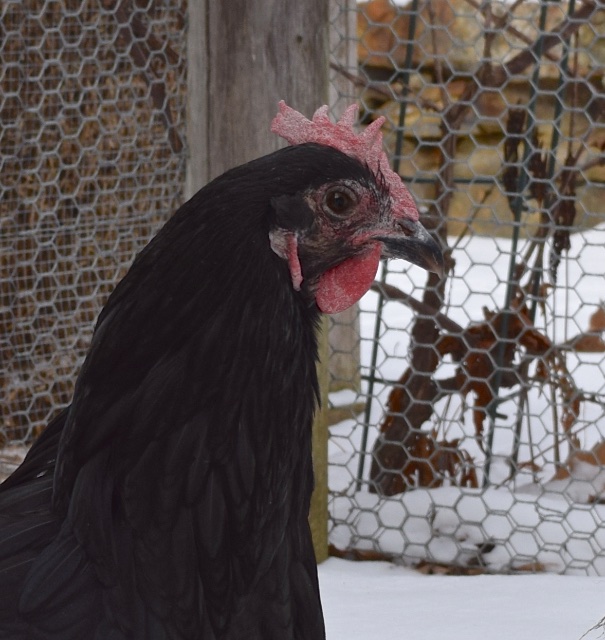
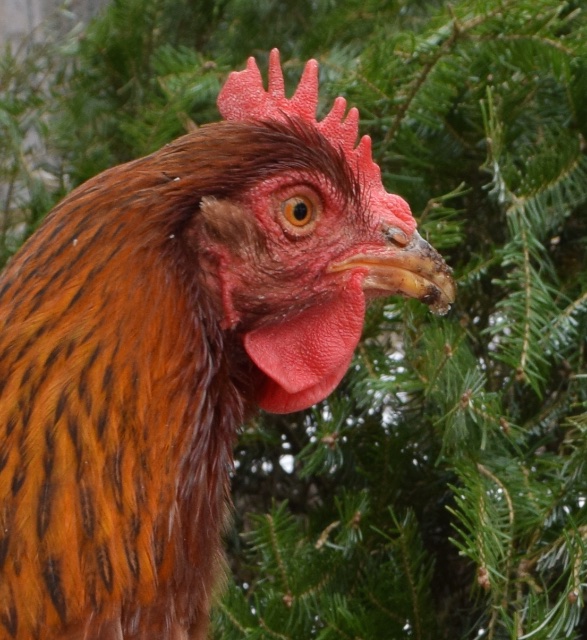
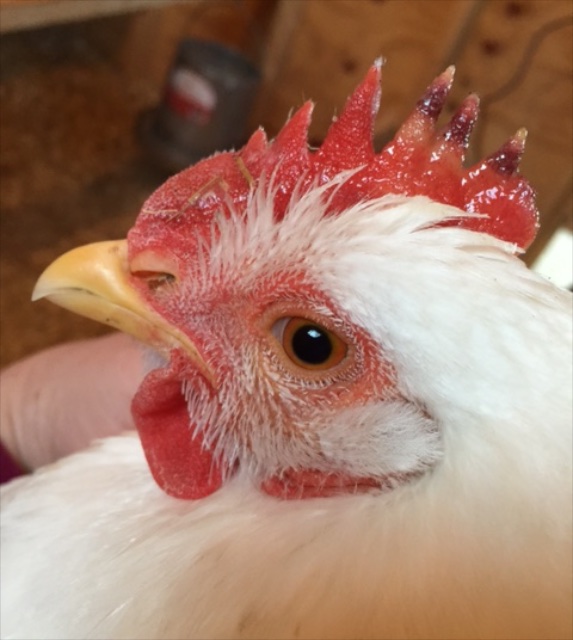
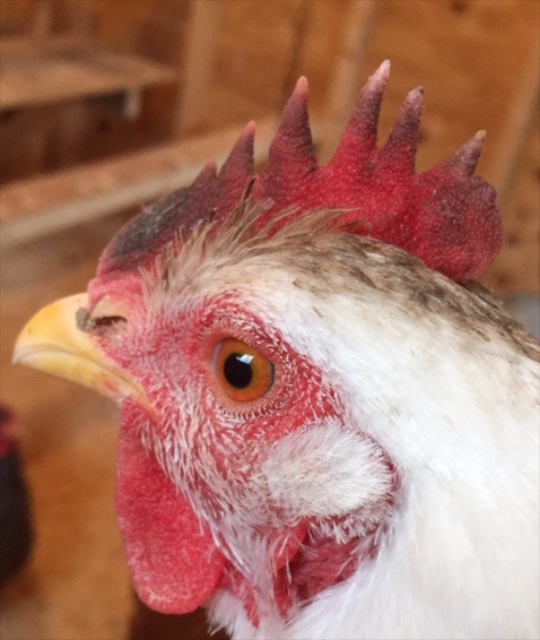
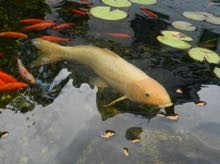
I noticed last nigjt that my BJG Roo had the beginnings of frostbite on the tips of his ridiculously large comb, I slathered it in Vasoline and checked over my hens amd all were fine, even my leghorns.I think the problem is, is the we live very close to a river that doesnt freeze over and it has been very very windy. So I assume that may habe somethi.g to do with it… I keeo a clwan coop ans nitnis is well ventilated.
On nights when the temps are going to 5 degrees or less I lather my roos wattles and comb with Vaseline. This isn’t a problem if you only have one or two roos.
Over the years I rarely have had hens suffer from frostbite but roosters from some reason seem to be more vulnerable especially the wattles, which is caused by water freezing on them after they drink.
A couple of nights ago it gone down to zero degrees (F). I shut the one south facing window I usually just leave open. When I went to the coop the next morning all four windows were frosted over. Not good. The one south facing window has remained open every since and no moisture build up. No more frosty windows.
I have two vents in the coop one on either side of the coop but I don’t think they are large enough to create proper ventilation.
Terry-I believe I have solved my mystery! As I sat still in their coop yesterday, daydreaming and trying to nail down how frostbite could possibly become an issue for my girls, I was admiring the sun shining in through their little door. While looking at the bright sunshine I noticed ever so slightly but very clearly the illumination of steam rising out of their drinker. As the volume of water drops later in the day from the drinker, I believe the water heater platform is warming the water enough to create steam. Not a problem early in the day when the volume is high but very much a problem as the day closes and water volume is lower. Their drinker is never less than ½ full but I believe its low enough to set the stage for the steam. Combined with the bitter cold winds I believe this was my cocktail for frostbite. The good news is this is an easy fix and my girls are very much on the mend! Stay warm everybody and keep Jack Frost away from your hens!
On a side note, I probably wouldn’t have noticed the steam if I hadn’t been “just sitting there”. The quiet mind I gain from socializing with my girls was well served in solving this one!
Genius observations, Liz! I feel like Yoda to a young Jedi, you have learned well the power of quietly paying attention!
Good point! As the girls don’t drink at night anyway, I remove the waterer from the coop on very cold nights.
Although I don’t think the steam is causing a moisture issue in the coop. I think the source of damage is when they are drinking they are essentially getting a face/comb steam bath then turning around to ice cold temps. The steam is dampening their combs enough to leave them open to injury.
Timely post. I’ve never owned a roo before until this year and his comb is huge. He’s got frostbite pretty bad from the severe cold we had last week. I’m watching him closely but he’s super hard to catch in order to put ointment on his comb. :( I hope he heals up on his own.
Kris, are you able to pick him up in the evening? I do that often and I use a very dim light like a head lamp.
I have them settle down on my lap before I even try to apply anything. I know it’s tough. Good luck!
Exactly what I was going to recommend. That’s another reason why a walk-in coop is so useful- you can easily pick chickens off the roost at night when you need to separate or doctor them.
:D I bet you had some fun getting all those head shots in the cold!
I don’t have chickens, but I do have little birdies I feed in my yard. Piles of sticks and evergreen bushes and trees help them with the cold and wind. They are a good temperature gauge. If I look out my livingroom window and see the bush next to the porch is twitching about, I know it is full of birds hunkered down for the day (although they never really sit still for long). That means time for the parka!
Boy. You read a lot these days about people starting to raise backyard hens to provide their family with fresh, wholesome eggs. But…like a lot of things in life…it sure is a lot more complicated and entails a lot more work than the uninitiated would think!
Yes! I’m not one who thinks that everyone should have chickens. Of course I think that about dogs and guinea pigs and horses and goldfish too…
I know this is not your recommendation but I have good success with providing a small flood light in the coop for my hens to provide just enough heat to keep the temp in there above freezing. It does not give off the tremendous heat that a heat lamp provides, and they look healthy and content. I feel better knowing they have a bit of warmth on these really cold days and especially nights. I have heard the arguments against the light and added warmth but for me this has worked well and I have not had any frostbite issues over the years.
The problem with a light is that continuous light isn’t good for hens. Studies done on commercial flocks show a decrease in laying and health with continual light. They need to be in the dark for a few hours. These effects aren’t as obvious in our less productive backyard birds.
Thank you, Elizabeth, for your suggestion. We don’t have a walk in coop ( something I would do differently if I could go back and do it again!) but he does spend the beginning part of the night in the nest box….so maybe I can peek in on him then and try to apply some ointment. His comb really does look awful. :( I feel terrible for him. Though he was happily eating the oatmeal I threw in the coop this morning. I also worry because he’s the new guy and the girls aren’t that nice to him.
awesome post and comments, very helpful, ty all :)